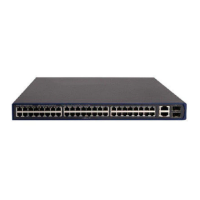65
NOTE:
• Disable SNMP logging in normal cases to prevent a large amount of SNMP logs from decreasin
device
performance.
• The total output size for the node field (MIB node name) and the value field (value of the MIB node) in
each log entry is 1024 bytes. If this limit is exceeded, the information center truncates the data in the
fields.
Configuring SNMP traps
Introduction to SNMP traps
The SNMP agent sends traps to inform the NMS of important events, such as a reboot.
Traps fall into generic traps and vendor-specific traps. Available generic traps include authentication,
coldstart, linkdown, linkup and warmstart. All other traps are vendor-defined.
SNMP traps generated by a module are sent to the information center. You can configure the information
center to enable or disable outputting the traps from a module by their severity and set output
destinations. For more information about the information center, see the chapter “Information center
configuration.”
Enabling SNMP traps
Enable SNMP traps only when necessary. SNMP traps are memory-intensive and may affect device
performance.
Follow these steps to enable traps:
To do… Use the command… Remarks
Enter system view system-view —
Enable traps globally
snmp-agent trap enable [ arp rate-limit |
configuration | default-route | flash | standard
[ authentication | coldstart | linkdown | linkup |
warmstart ]* | system ]
Required
By default, all traps are
enabled.
Enter Layer 2 Ethernet port
view, or VLAN interface
view
interface interface-type interface-number Required
Enable link state traps enable snmp trap updown
Required
Enabled by default.
NOTE:
• To generate linkUp or linkDown traps when the link state of an interface changes, you must enable the
linkUp or linkDown trap function globally by using the snmp-agent trap enable [ standard [
linkdown
| linkup ] * ] command and on the interface by using the enable snmp trap updown command.
• After you enable a trap function for a module, whether the module
enerates traps also depends on the
configuration of the module. For more information, see the configuration guide for each module.

